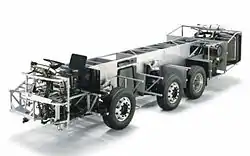Rolling chassis
A rolling chassis is the fully-assembled chassis of a motor vehicle (car, truck, bus, or other vehicle) without its bodywork. It is equipped with running gear (engine and drivetrain) and ready for delivery to a coachbuilder to be completed. Historically, bespoke luxury automobiles were finished inside and out to an owner's specifications by a coachbuilder, and specialty vehicles (such as fire engines) were outfitted by firms devoted to that task.

Heavy vehicles


Separate chassis remain in use for almost all heavy vehicles ranging from pickup trucks to the biggest trucks and commercial passenger carrying vehicles.
The rolling chassis is delivered to the commercial body maker, coachbuilder, or bulk transporter on its own wheels, under its own power.
Automobiles
Rolling chassis was a stage of manufacture of every vehicle. Mass produced cars were supplied complete from the factory, but luxury cars like Rolls-Royce were supplied as a chassis from the factory to several bespoke coachbuilders like J Gurney Nutting & Co who would supply a body to the customer's order (or build a car which was sold from their showroom).
Automobile construction methods changed when unibody or monocoque combined chassis and body structures gradually replaced chassis.
Gallery
.jpg.webp) Rolling X-frame chassis
Rolling X-frame chassis Rolling platform frame AK 427 Cobra replica rolling chassis
Rolling platform frame AK 427 Cobra replica rolling chassis Hand-crafted space frame Mercedes 300 SL Gullwing W180 in "rolling chassis" form during restoration
Hand-crafted space frame Mercedes 300 SL Gullwing W180 in "rolling chassis" form during restoration
See also
![]() Media related to Rolling chassis at Wikimedia Commons
Media related to Rolling chassis at Wikimedia Commons
- Glider (automobiles), an otherwise complete motor vehicle that lacks some or all of the powertrain